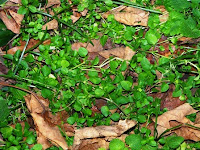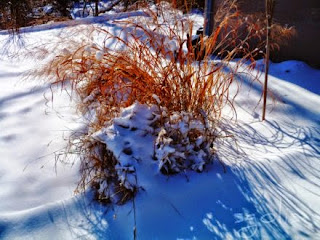Make a Balsam garden wreath by collecting material that
you find in your yard or in the woods. A wreath that is made from
material found in nature is eye appealing and unique as well as a gift
to wildlife and to the birds.
Gathering Filler for Wreath
Today I took a small pail and a scissor
along with me when I went for my hike in the forest. I ventured off
trail to seek pine cones and to cut winter berry branches at three
inches. I found the berries growing on shrubs some were blue and others
were red. These colors would look nice on a balsam wreath. In my yard I
cut branches from my holly bush, plumes from my fountain grass and sprigs from lavender, peppermint and basil herbs.
Now that I had the filler for the wreath I needed to buy the balsam wreath from the Christmas tree lot.
 |
| Winter Berries from Forest |
I bought two balsam wreaths that were $11.00 each. Note this is my only out of pocket expense.
Getting Ready
Working with items from nature can be messy and there may be insects too so I put the wreath together outdoors on my patio table. Working with natural products requires you to have a gentle touch as they can break easily.
Lay out the filler for the wreath so it is separated and you can easily grab it when needed.
Before beginning the arrangement of the filler I gently opened up the balsam wreaths branches so that it did not look flat. When I was satisfied with the fuller appearance I got busy with the filler arranging.
Putting Wreath Together
Getting Ready
Working with items from nature can be messy and there may be insects too so I put the wreath together outdoors on my patio table. Working with natural products requires you to have a gentle touch as they can break easily.
Lay out the filler for the wreath so it is separated and you can easily grab it when needed.
Before beginning the arrangement of the filler I gently opened up the balsam wreaths branches so that it did not look flat. When I was satisfied with the fuller appearance I got busy with the filler arranging.
Putting Wreath Together
 |
| Open the balsam branches so wreath looks full |
Natural Pine cones  are a key focal material so I attached craft wire
are a key focal material so I attached craft wire  to the base of my pine cone so that it would stay in place on the wreath.
to the base of my pine cone so that it would stay in place on the wreath.
To keep the wreath balanced I attached one pine cone at the top of the wreath, off to the side slightly so it would not be covered by the wreath hanger . The other two pine cones were attached on the sides closer to the bottom of the wreath. The pine cones were my focal area and the filler would be the fluff.
. The other two pine cones were attached on the sides closer to the bottom of the wreath. The pine cones were my focal area and the filler would be the fluff.
To keep the wreath balanced I attached one pine cone at the top of the wreath, off to the side slightly so it would not be covered by the wreath hanger
 |
| Highlight pine cone with winter berries |
Red and purple berries were added around the pine cones to add color and interest. The rest of the wreath filler was added to the base to give the wreath color flow.
The sprigs of herbs added additional fragrance to the wreath as well as interest. I finished the wreath by adding plumes of fountain grass. The grass gave the wreath interest and it was a good contrast.
I hung one wreath on my front door and the other on my front garden gate. My neighbor admired it and asked me if I would make her one. I sold my one wreath for $36.00.
Making balsam wreaths is a great way to earn extra money. It took me twenty minutes from start to finish to make the wreath. The time most used was wiring the pine cones
 |
| Balsam Garden Wreath hung on Gate
Learn more about designing wreaths from balsam:
|
The balsam garden wreath is a practical way to decorate as you can display this wreath throughout the winter season and it looks especially nice during the Christmas.



















